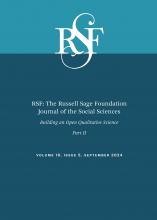Research Article
Open Access
How Americans Judge: A Topology of Moral Communities
James Chu, Seungwon Lee
RSF: The Russell Sage Foundation Journal of the Social Sciences September 2024, 10 (5) 141-164; DOI: https://doi.org/10.7758/RSF.2024.10.5.06
James Chu
aAssistant professor of sociology at Columbia University, United States
Seungwon Lee
bPhD candidate at Columbia University, United States

REFERENCES
- ↵
- Abele, Andrea E., and
- Bogdan Wojciszke
- ↵
- Abele, Andrea E., and
- Bogdan Wojciszke
- ↵
- ↵
- Bellah, Robert N.,
- Stephen M. Tipton,
- William M. Sullivan,
- Ann Swidler, and
- Richard Madsen
- ↵
- Bourdieu, Pierre
- ↵
- Bourdieu, Pierre
- ↵
- Bourdieu, Pierre, and
- Jean-Claude Passeron
- ↵
- Boutyline, Andrei, and
- Laura K. Soter
- ↵
- Boutyline, Andrei, and
- Stephen Vaisey
- ↵
- Calarco, Jessica McCrory
- ↵
- Campbell, Colin
- ↵
- Chen, M. Keith, and
- Ryne Rohla
- ↵
- D’Andrade, Roy G
- ↵
- ↵
- DiMaggio, Paul
- ↵
- DiMaggio, Paul
- ↵
- Edin, Kathryn J.,
- Corey D. Fields,
- David B. Grusky,
- Jure Leskovec,
- Marybeth J. Mattingly,
- Kristen Olson, and
- Charles Varner
- ↵
- England, Paula
- ↵
- Feinberg, Matthew, and
- Robb Willer
- ↵
- Finkel, Eli J.,
- Christopher A. Bail,
- Mina Cikara,
- Peter H. Ditto,
- Shanto Iyengar,
- Samara Kiar,
- Lilliana Mason, et al
- ↵
- Fiske, Susan T
- ↵
- Fiske, Susan T.,
- Amy J. C. Cuddy, and
- Peter Glick
- ↵
- Fiske, Susan T.,
- Amy J. C. Cuddy,
- Peter Glick, and
- Jun Xu
- ↵
- Frost, Jacqui, and
- Penny Edgell
- ↵
- Gast, Melanie Jones, and
- Dina G. Okamoto
- ↵
- Goldberg, Amir
- ↵
- ↵
- Graham, Jesse,
- Jonathan Haidt, and
- Brian A. Nosek
- ↵
- Gusfield, Joseph R
- ↵
- Hechter, Michael,
- James Ranger-Moore,
- Guillermina Jasso, and
- Christine Home
- ↵
- Jack, Anthony Abraham
- ↵
- Kaufman, Jason
- ↵
- Khan, Shamus
- ↵
- Koch, Alex,
- Roland Imhoff,
- Ron Dotsch,
- Christian Unkelbach, and
- Hans Alves
- ↵
- Lamont, Michèle
- ↵
- Lamont, Michèle, and
- Virág Molnár
- ↵
- Lareau, Annette
- ↵
- Lassetter, Bethany,
- Eric Hehman, and
- Rebecca Neel
- ↵
- Lipset, Seymour M., and
- Gary Marks
- ↵
- ↵
- Massey, Douglas S
- ↵
- Mills, C. Wright
- ↵
- Mohr, John W
- ↵
- Piff, Paul K.,
- Michael W. Kraus,
- Stephane Cote,
- Bonnie Hayden Cheng, and
- Dacher Keltner
- ↵
- Ridgeway, Cecilia. L
- ↵
- Risman, Barbara. J
- ↵
- Rivera, Lauren A
- ↵
- Rosenberg, Seymour,
- Carnot Nelson, and
- P. S. Vivekananthan
- ↵
- Sauder, Michael,
- Yongren Shi, and
- Freda Lynn
- ↵
- Sayer, Andrew
- ↵
- Schwartz, Shalom H., and
- Tammy Rubel
- ↵
- Swidler, Ann
- ↵
- Thai, Mai
- ↵
- Thornton, Patricia H.,
- William Ocasio, and
- Michael Lounsbury
- ↵
- Tilly, Charles
- ↵
- Tomaskovic-Devey, Donald, and
- Dustin Avent-Holt
- ↵
- Traag, Vincent A.,
- Ludo Waltman, and
- Nees Jan van Eck
- ↵
- ↵
- Valentino, Lauren, and
- Stephen Vaisey
- ↵
- Zou, Linda X., and
- Sapna Cheryan
- ↵
- Zilberstein, Shira,
- Elena Ayala-Hurtado,
- Mari Sanchez, and
- Derek Robey
In this issue
How Americans Judge: A Topology of Moral Communities
James Chu, Seungwon Lee
RSF: The Russell Sage Foundation Journal of the Social Sciences Sep 2024, 10 (5) 141-164; DOI: 10.7758/RSF.2024.10.5.06
Jump to section
Related Articles
- No related articles found.
Cited By...
- No citing articles found.





